Wild weather week possible in California as humid heat transitions to potential dry-to-wet thunderstorm outbreak thanks to tropical storm remnants
Early September lightning outbreak brings many wildfires, with some damage, but lack of NorCal drought prevents worse outcome
The month of September started with a bang–or, rather, the near-constant rumble of thunder from thousands of lightning strikes amid an intense thunderstorm outbreak that affected a broad portions of interior central and much of northern California. (These were, BTW, the “potential surprises” I alluded to in the last blog post.) Many of these storms, especially initially, produced dry lightning (i.e., were associated with little or no rainfall). Many dozens of vegetation/wildfires were reported–and a handful of these went on to become large, threatening, and/or damaging–mainly in the Sierra Nevada foothills. The most destructive of these numerous lightning-ignited blazes, dubbed the “6-5 Fire,” overwhelmed the small but historic (and still actively populated) foothill community of Chinese Camp. Nearly the entire town was destroyed–around 100 structures in total–along with a dozen or so structures in other fires in surrounding communities.
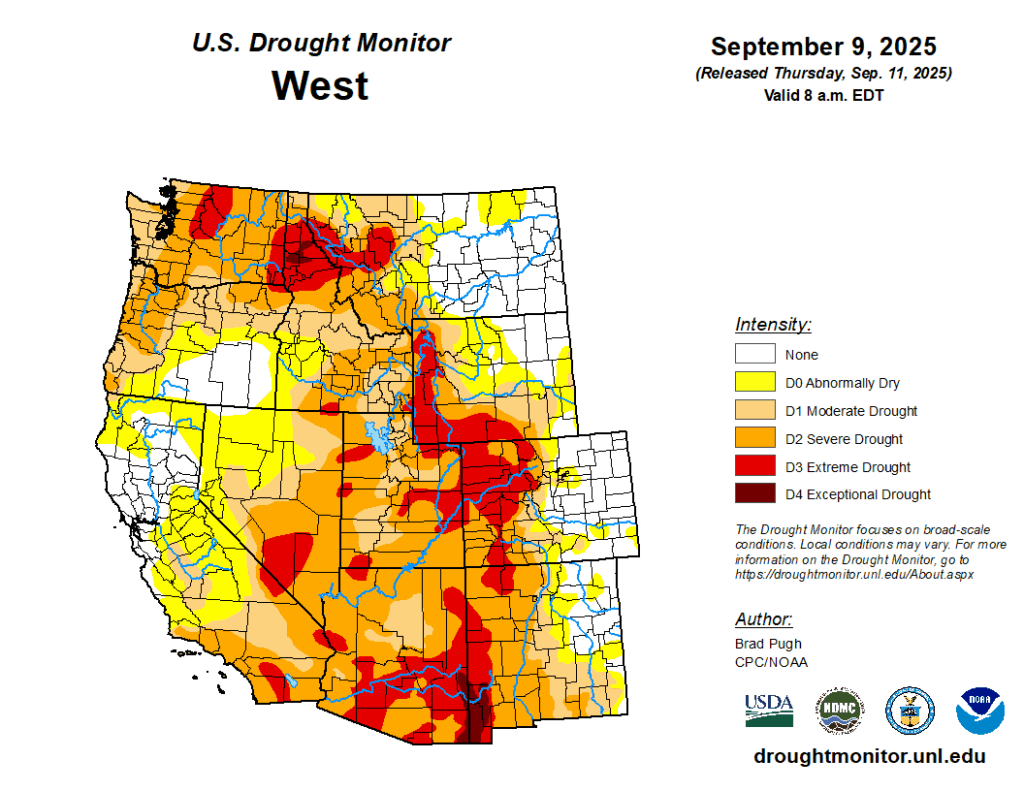
Yet despite these dozens of fires, and the very real devastation in Chinese Camp, the outcome could have been much worse but for a couple of major mitigating factors. First: the vast majority of dry lightning strikes actually occurred over the San Joaquin Valley floor or the lower foothills around it. This means that lightning occurred amid a mix of irrigated farm fields, grassland, and in the context of a major gridded road network. While many fires ignited in this area, they were generally smaller and/or easier to control in this setting (as opposed to the handful of fires that occurred in heavier brush and forest in the foothills–which collectively went on to burn structures and tens of thousands of acres). Had this dry lightning event been focused either farther west (over the Coast Ranges) or farther east (over the Sierra upper foothills/crest)–more numerous and more “problematic” ignitions would likely have occurred.
But perhaps the more important mitigating factor–which bears repeating given potential events to come this week–is the lack of severe drought conditions in Northern California. Unlike nearly the entire west of the Western United States, where severe to extreme drought is widespread (including in SoCal), NorCal is largely drought-free at the moment. This is in great contrast to the summer/fall of 2020, when an historic dry lightning outbreak from the SF/Monterey Bay region into interior NorCal brought an extremely destructive wildfire outbreak. Folks may recall that an extreme drought was ongoing at that point, which allowed this remarkable dry thunderstorm event to ignite literally hundreds of simultaneous fires under extreme burning conditions. At present, we simply don’t have that extreme level of vegetation aridity in Northern California, and even in southern California drought is not is severe today as it then in NorCal. It’s certainly dry out there, and there will likely be some lightning-ignited wildfires this week that could cause problems, but August 2020 this is not. However…
A very complicated meteorological set-up this week, but rising potential for some wild California weather (despite high uncertainty)
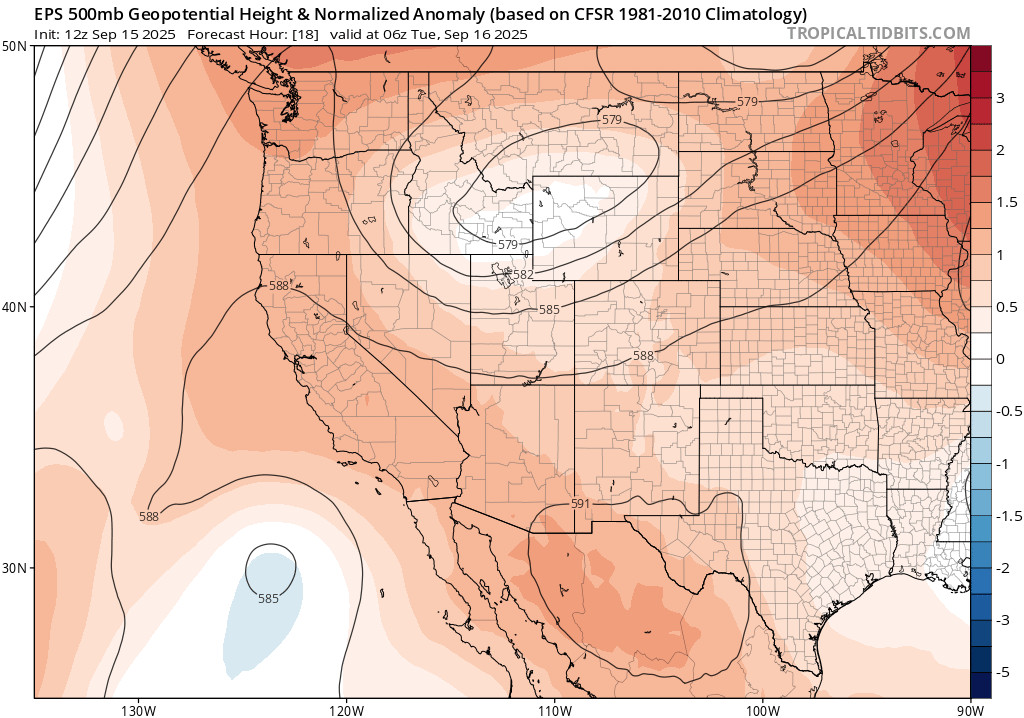
Despite the fortuitous lack of severe NorCal drought, there are actually some notable short term meteorological similarities between the upcoming weather set-up this week and that during the August 2020 event. In that case, a very moist airmass (aloft) coincided with a very dry airmass near the surface and strong atmospheric instability to generate strong to severe dry thunderstorms over the SF Bay region and northward. This moisture and instability was contributed by the offshore remnants of then-former East Pacific Hurricane Fausto. The remarkable signature of this event was the very high level of atmospheric moisture that was present, allowing for robust thunderstorm development, yet the very dry near-surface air that allowed heavy downpours aloft to almost entirely evaporate before hitting the ground (preventing wildfire-mitigating wetting rainfall and also generating severe downdraft winds of 60-70+ mph).
The pattern this week, in NorCal at least, does appear to be at least somewhat similar to that August 2020 event. First, and at present, a very warm and dry airmass is present across nearly all of California with widespread 90s/low 100s inland (and unusually warm, though muggier, conditions along the coast). This hot weather will continue on Tuesday and Wednesday, though with increasing clouds by Wednesday afternoon. It will also become conspicuously muggier, even across inland areas, as subtropical/tropical moisture begins to pool (especially along the coast, where it could even become oppressive in some SoCal spots).
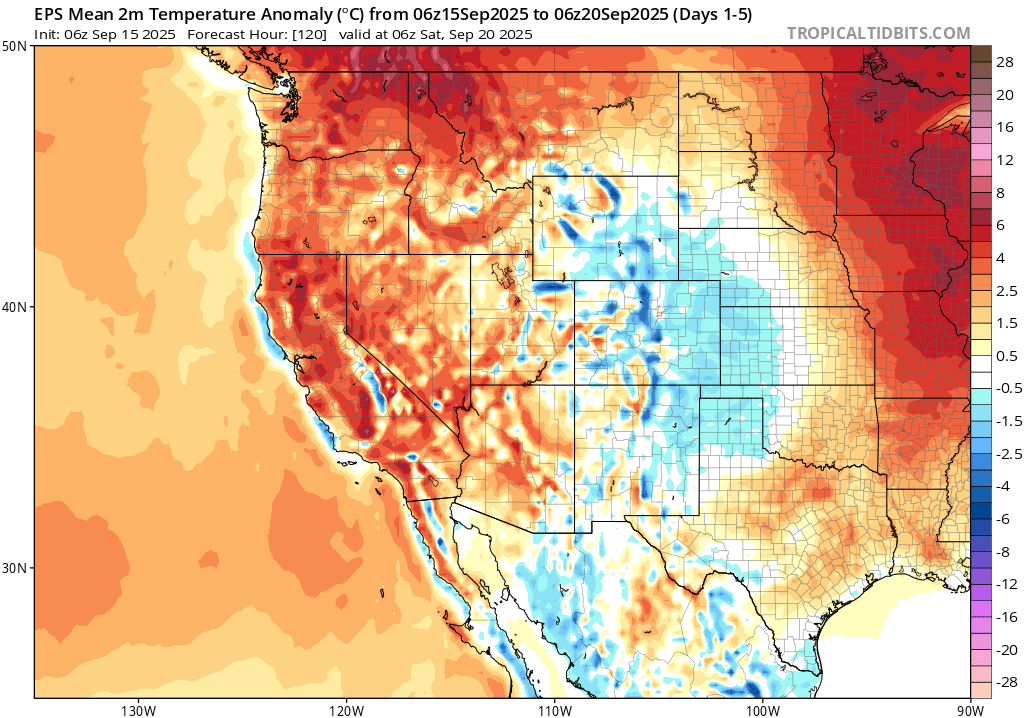
Then, Wed into Thu, the remnants of then-former Tropical Storm Mario will slowly move northward to a position somewhere offshore of the Central Coast. A plume of very deep/anomalous atmospheric moisture will move still further north, though with a sharp northward cut-off somewhere (likely over/near San Francisco). Meanwhile, an axis of considerable elevated instability (CAPE in the most unstable layer of 500-1,000 J/kg, which is nothing to sneeze at in this part of the world) will align along and just south of the northward extend of this moisture axis.
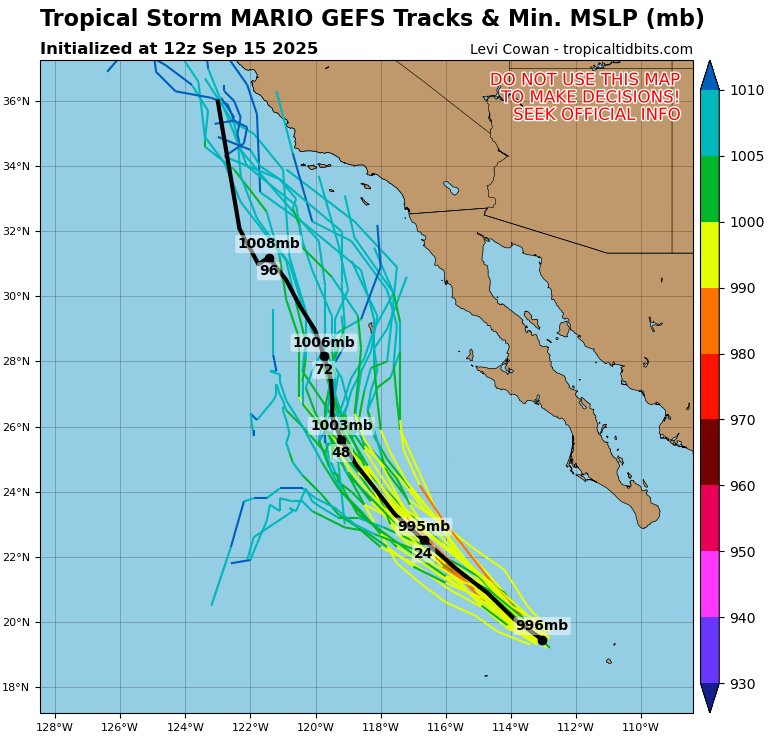
There are a whole lot of moving parts to this forecast–and the “phasing” (i.e., spatiotemporal overlap) between moisture, instability, and “forcing” (i.e., upward vertical motion) is critical to predicting outcomes in this kind of situation. That’s why model forecasts for specific locations are oscillating wildly from forecast cycle to forecast cycle in specific locations (so beware the automated weather app, especially this week!). But this overall pattern looks remarkably favorable for fairly widespread thunderstorm outbreaks in different parts of California over the coming (details below). The exact evolution will depend on details that are still not fully clear (or even hypothetically resolvable yet at this time horizon, even just 2-3 days out). But I would be pretty surprised if the week ends without at least some (wet) thunderstorms in SoCal, including coastal areas, and some dry (or dry-ish) thunderstorms in NorCal (especially closer to the SF Bay region). Some locations may stay completely dry, with no lightning; others could see locally torrential downpours, or otherwise multiple hours of dry lightning. In short: it’s an extraordinarily complex meteorological set-up, and conditions may vary quite widely across the state in the coming days (but could nonetheless be locally quite consequential).
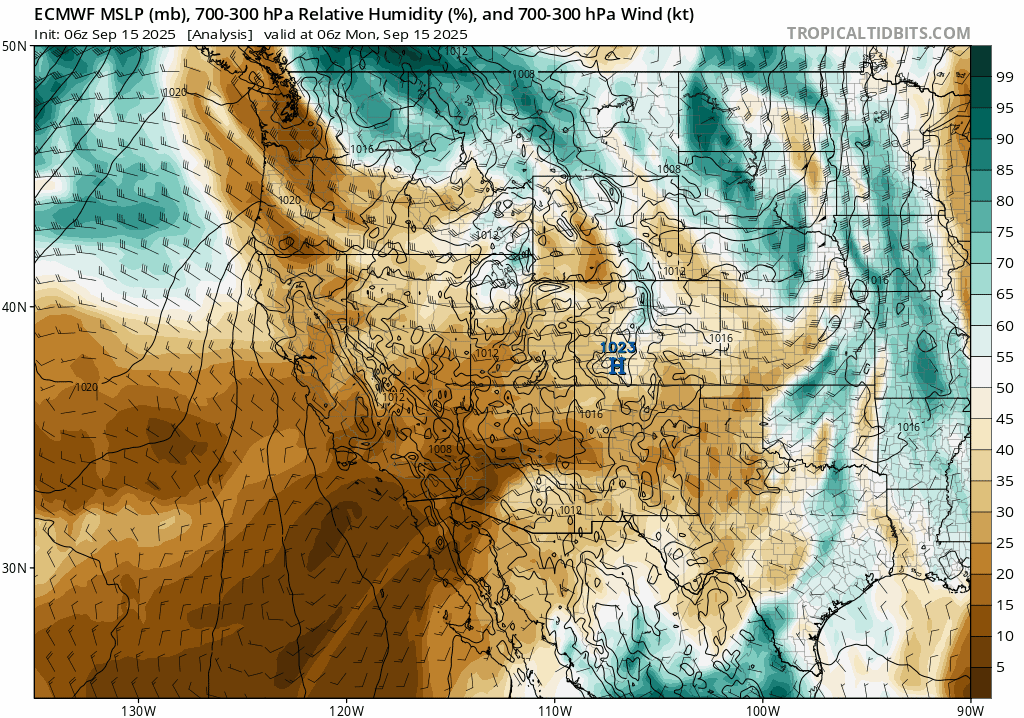
Widespread thunderstorm outbreak(s) possible later this week into next week; likely wet in SoCal, and possibly dry NorCal
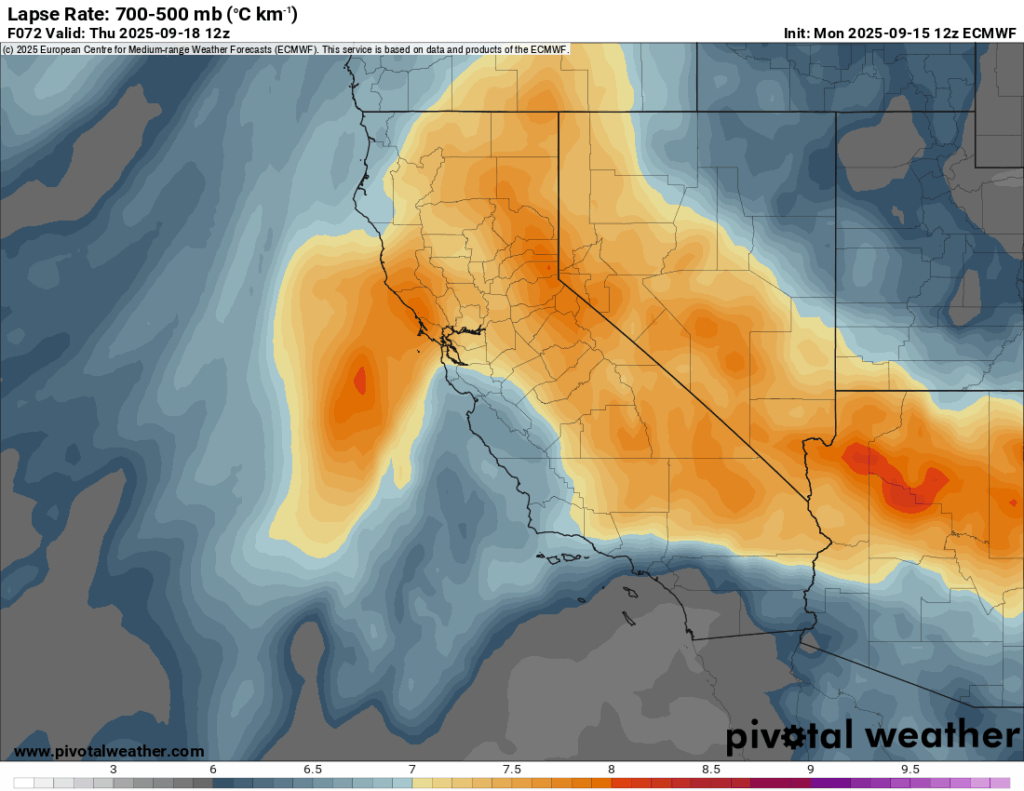
As noted above: all of the key ingredients needed for a major autumn thunderstorm outbreak in California will be in place later this week. The big question remains: where, when, and to what extent will these ingredients align? In general, with a much moister airmass in SoCal, there is a much higher chance that those storms which do form will generate wetting (or even quite heavy) local rainfall. Storms may start out on the drier side, and there could be some lightning ignitions initially down south, but storms should fairly quickly transition toward generating wetting to significant rainfall. In fact, there will be a non-trivial risk of flash flooding where the strongest storms set up; as usual, the risk is highest over mountain/desert areas as well as recent burn areas, but in this kind of patterns it’s possible to get an isolated slow-moving cell that drops a lot of water quite quickly almost anywhere, even across the coastal plain (so keep an eye out!).
As has often been the case historically in similar set-ups, however, it is central and northern California that is at much higher risk of dry thunderstorms (and subsequent wildfire ignitions). The axis of maximal instability is not yet clear, but right now the ECMWF and GFS both put it somewhere over the SF Bay Area (so there is a real threat of storms at least that far north). The greatest risk of dry lightning will likely be along and just north of this axis–where dry air at the surface will coincide with very moist and moderately unstable air aloft. This far north, nearly all convection would be elevated (i.e., with cloud bases 10k+ feet above the ground) and produce little or no accumulating rainfall at the surface despite generating lightning. Moreover, such clouds would be capable of strong and gusty downburst winds as well. Later in the event, any storms that form would likely transition toward mixed dry/wet even up north as moisture increases throughout the column–but not all areas would see rain, and lightning/strong winds would still occur outside of narrow rain cores (and thus contribute to a fire threat).
So, long story short: there is a pretty good chance of thunderstorms later this week across the southern 2/3 to 3/4 of California, and the storms are more likely to be dry the farther north one goes (and, hence, are likely to be wet and even heavy in SoCal except possibly at the outset). Lightning fire ignitions are possible, especially from Central Coast northward. And some surprises are certainly possible (including locally heavy rain in central/NorCal, or drier storms than expected in SoCal).
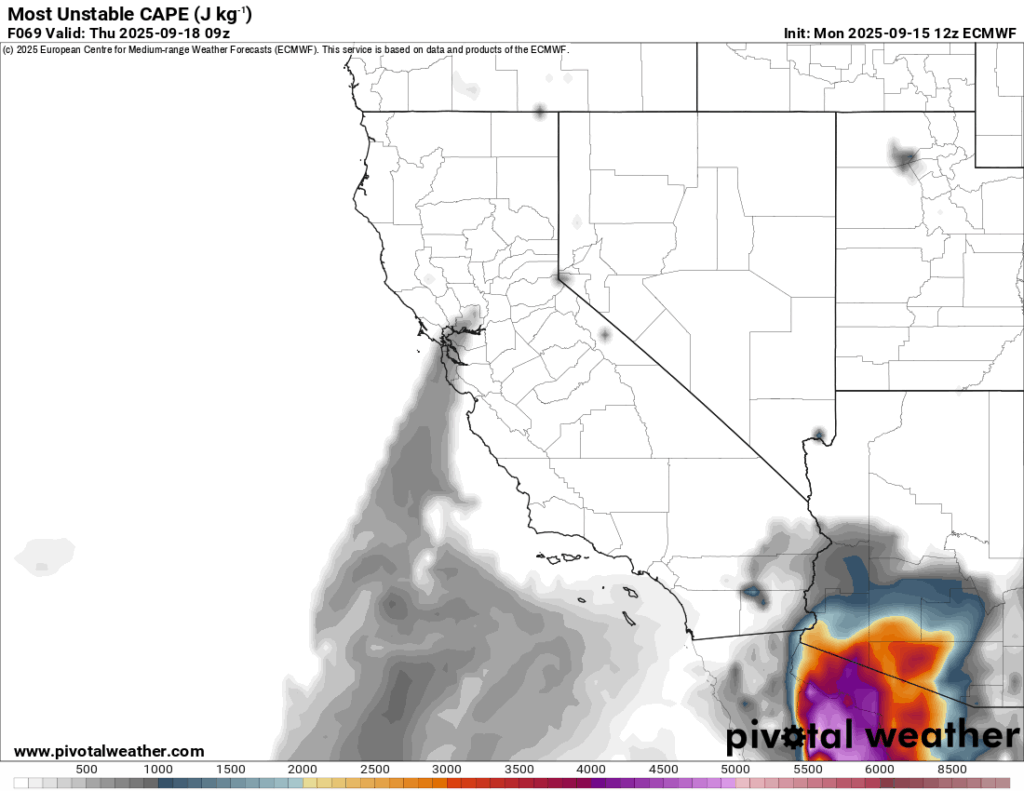
Elevated lightning fire risk, mainly central/northern CA (but see caveats!)
There is, as noted above, a notably elevated risk of dry lightning across portions of central and northern California this week; the pattern also bears some similarities to the August 2020 event. However, as is also discussed previously, northern (and, for the most part, central) California is not experiencing a severe drought at present. This is a really important distinction, as the extreme wildfire burning conditions that preceded the massive dry lightning event in 2020 are not, and will not be, in place this week. In fact, over the past 10 days, substantial showers have fallen across much of northwestern (and portions of interior northern) California. Some lighter showers even occurred as far south as (portions of) the SF Bay Area and locally in the Sierra foothills. None of these should be considered “fire season-ending” rains, though where at least a half inch or so fell they have undoubtedly served as substantively “fire season-mitigating” ones. This, combined with recent higher humidity and non-extreme temperatures, sets a decidedly less dire stage against which any dry lightning, and subsequent fires, would emerge this week.
All of this is to say: the dry lightning risk this week is considerable (albeit with high uncertainty). But the overlap between the greatest dry lightning risk region and severe drought region is minimal, and this does lead to a significantly less dire scenario than other dry lightning events (or potential such events) that have unfolded in other, drier years.
I will say, however, that there is a swath from the mid-Central Coast to the central SF Bay region that is experiencing some modest to moderate level of anomalous annual-scale dryness and which has not received any recent rainfall which may be most at risk of dry lightning-ignited fires. And it’s also the case that the present 3-4 day long heatwave, though not extreme, is reaching all the way to the coast and is rapidly drying fine fuels (i.e., grasses). So suffice it to say that I’ll be keeping a very close eye on how this all evolves later this week into next.
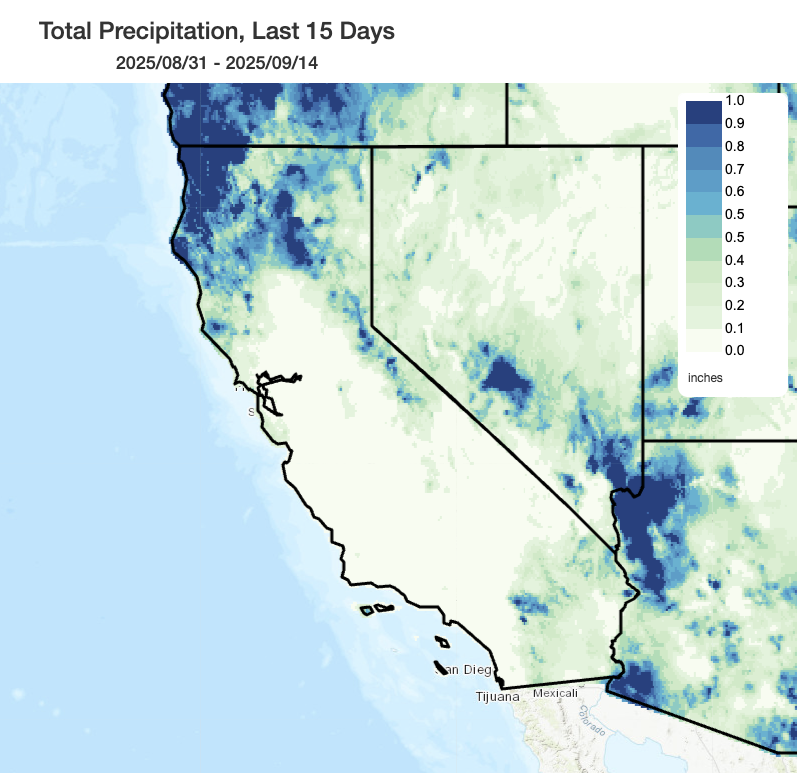
Unusually active and convectively unstable pattern may continue into next week amid now extreme Pacific marine heatwave
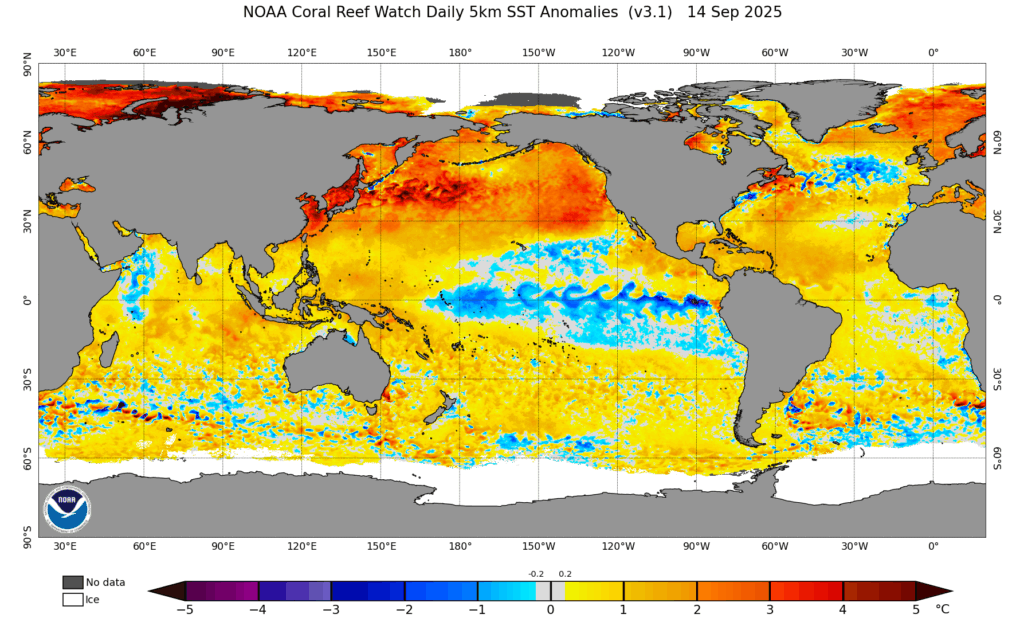
There is another major event unfolding that is directly relevant to California weather, and this one is literally thousands of miles wide: an extremely broad, intense, and prolonged marine heatwave (now record-breaking to record-shattering in some areas) now extends clear across the North Pacific from China/Japan to California/Mexico. This enormous patch of much warmer-than-average water extends to the immediate near-shore waters in California, and is bringing very warm overnight temperatures as well as muggy conditions along the coast and in coastally-influenced areas inland.
Aside from likely allowing for some unusual subtropical marine life sightings off the California coast in the near future, it’s also adding a lot of extra moisture to the lower atmosphere compared to what is usual for the time of year. This will likely allow tropical moisture moving up from the south in the coming days, both associated with former TS Mario and otherwise, to linger a bit more intensely/for longer than would otherwise be the case. It may also be a leading influence for the rest of the autumn to come (I will discuss that more in a future blog post). But in the short term, it’ll make the upcoming pattern feel even more anomalous for California in terms of humidity and overnight warmth.
Finally: there are already signs of a potential second wave of subtropical moisture in California about 1 week from now. It could, once again, bring a threat of wet/dry thunderstorms to various parts of the state. As this post is already running long, and the details are very murky at this point, I’ll plan on discussing that in tomorrow’s YouTube livestream (see below) and on social media thereafter.
Join me live on Tue, Sep 16 @ 3:30pm PT (and likely again later in the week at TBD time as conditions warrant)
I’ll be live later tomorrow afternoon to discuss everything above, including the humid heat, record-breaking marine heatwave, tropical remnant movement into California and the subsequent thunderstorm outbreaks; as always, come with your questions and I’ll do my best to answer them live. I will likely also have a second session at some TBD time later this week given the high-impact weather expected and complexity of its evolution; stay tuned to social media for updates, or subscribe to the Weather West channel (and enable notifications!) to hear about these sessions automatically!